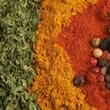Background
- Paprika is a spice made from the grinding of dried fruits of Capsicum annuum (sweet pepper or pimento). Sweet pepper is grown around the world and is used for color, flavor, and aroma. Some countries have used paprika for thousands of years. Now, it is most commonly grown in Hungary.
- Sweet peppers contain little or no compounds known as capsaicinoids. However, some paprika is made from hot varieties, which contain higher levels of capsaicinoids (such as capsaicin, present in chili peppers). Paprika is rich in antioxidants, including vitamin C, vitamin A, capsanthin, beta-carotene, lutein, and zeaxanthin. Many of these antioxidants are responsible for the color of paprika.
- Paprika has been used for various conditions, including nausea, vomiting, and the desire to drink alcohol. There is limited human data that Capsicum annuum may have beneficial effects when used as a source of antioxidants or to promote weight loss. Better-designed studies are needed.
References
- Aizawa K and Inakuma T. Dietary capsanthin, the main carotenoid in paprika (Capsicum annuum), alters plasma high-density lipoprotein-cholesterol levels and hepatic gene expression in rats. Br.J Nutr 2009;102(12):1760-1766.
View Abstract - Ebner C, Jensen-Jarolim E, Leitner A, et al. Characterization of allergens in plant-derived spices: Apiaceae spices, pepper (Piperaceae), and paprika (bell peppers, Solanaceae). Allergy 1998;53(46 Suppl):52-54.
View Abstract - Final report on the safety assessment of capsicum annuum extract, capsicum annuum fruit extract, capsicum annuum resin, capsicum annuum fruit powder, capsicum frutescens fruit, capsicum frutescens fruit extract, capsicum frutescens resin, and capsaicin. Int.J Toxicol 2007;26 Suppl 1:3-106.
View Abstract - Galgani J E, Ryan DH, and Ravussin E. Effect of capsinoids on energy metabolism in human subjects. Br.J Nutr 2010;103(1):38-42.
View Abstract - Gallo R, Roncarolo D, and Mistrello G. Cross-reactivity between latex and sweet pepper due to prohevein. Allergy 1998;53(10):1007-1008.
View Abstract - Garcia-Closas R, Berenguer A, Jose Tormo M, et al. Dietary sources of vitamin C, vitamin E and specific carotenoids in Spain. Br.J Nutr 2004;91(6):1005-1011.
View Abstract - Haramizu S, Mizunoya W, Masuda Y, et al. Capsiate, a nonpungent capsaicin analog, increases endurance swimming capacity of mice by stimulation of vanilloid receptors. Biosci.Biotechnol.Biochem 2006;70(4):774-781.
View Abstract - Kiokias S. and Gordon M. Dietary supplementation with a natural carotenoid mixture decreases oxidative stress. Eur.J Clin Nutr 2003;57(9):1135-1140.
View Abstract - Kawabata F, Inoue N, Yazawa S, et al. Effects of CH-19 sweet, a non-pungent cultivar of red pepper, in decreasing the body weight and suppressing body fat accumulation by sympathetic nerve activation in humans. Biosci.Biotechnol.Biochem 2006;70(12):2824-2835.
View Abstract - Macho A, Lucena C, Sancho R, et al. Non-pungent capsaicinoids from sweet pepper synthesis and evaluation of the chemopreventive and anticancer potential. Eur.J Nutr 2003;42(1):2-9.
View Abstract - Niinimaki A, Bjorksten F, Puukka M, et al. Spice allergy: results of skin prick tests and RAST with spice extracts. Allergy 1989;44(1):60-65.
View Abstract - Reinbach HC, Smeets A, Martinussen T, et al. Effects of capsaicin, green tea and CH-19 sweet pepper on appetite and energy intake in humans in negative and positive energy balance. Clin Nutr 2009;28(3):260-265.
View Abstract - Rosa A, Deiana M, Casu V, et al. Antioxidant activity of capsinoids. J Agric.Food Chem 12-4-2002;50(25):7396-7401.
View Abstract - Sun T, Xu Z, Wu CT, et al. Antioxidant activities of different colored sweet bell peppers (Capsicum annuum L.). J Food Sci 2007;72(2):S98-102.
View Abstract - Weintraub PG. Integrated control of pests in tropical and subtropical sweet pepper production. Pest.Manag.Sci 2007;63(8):753-760.
View Abstract







